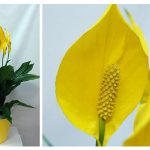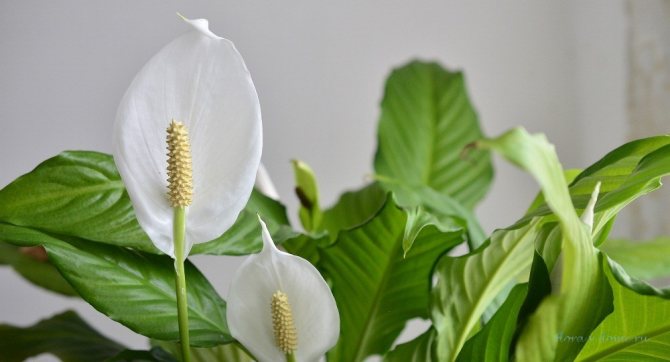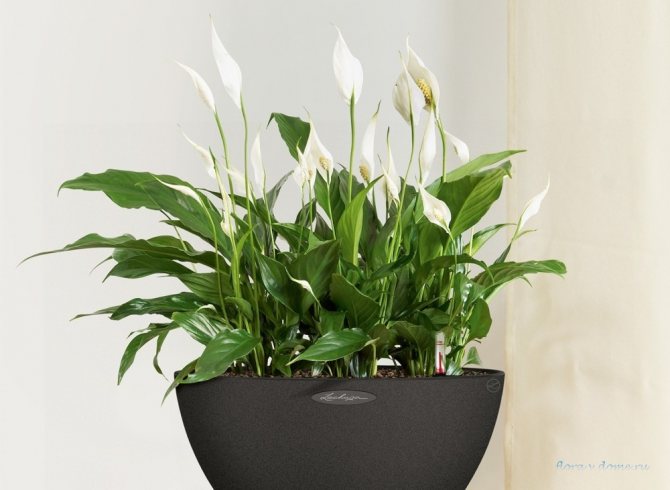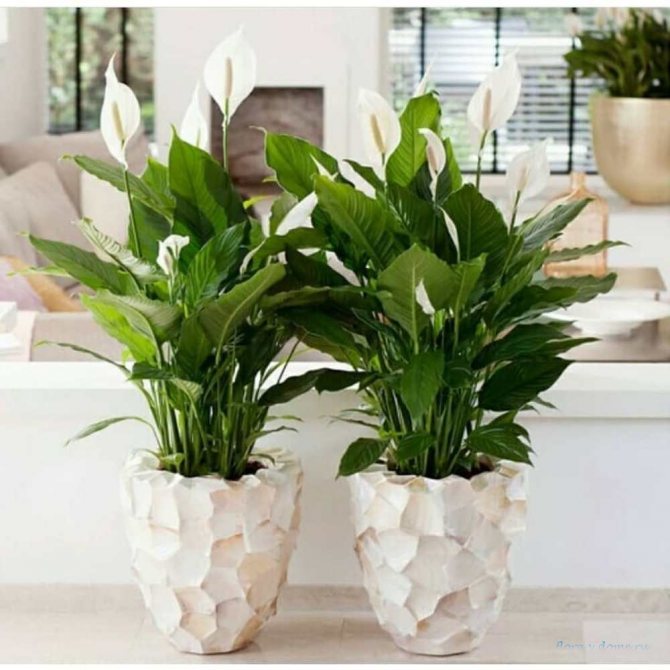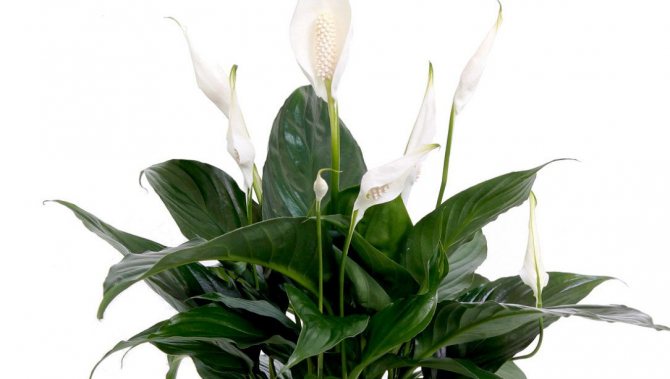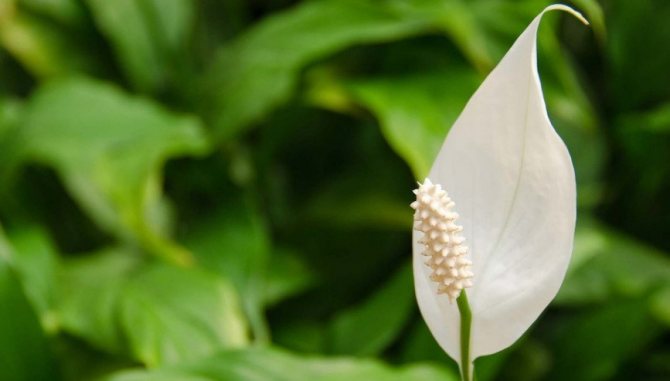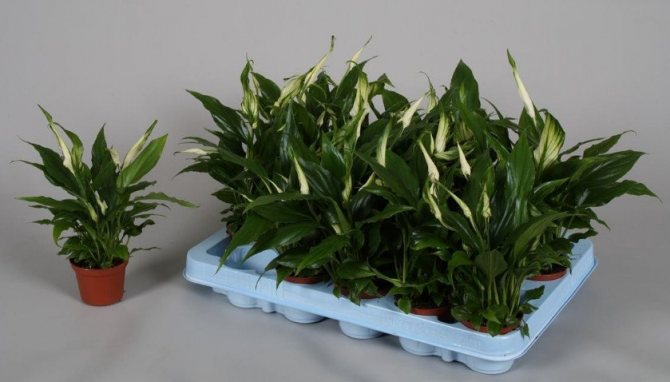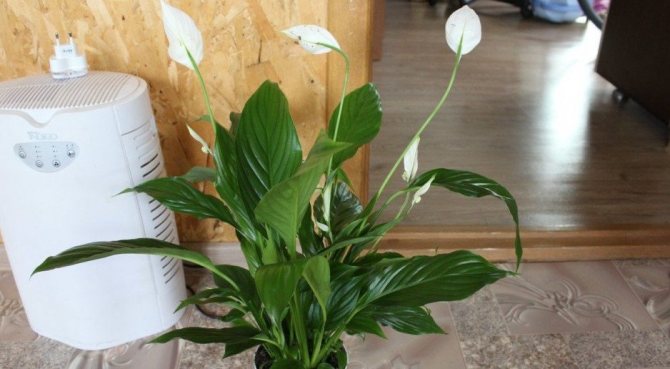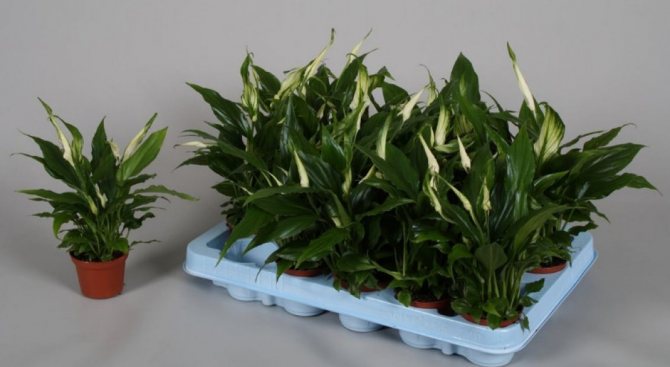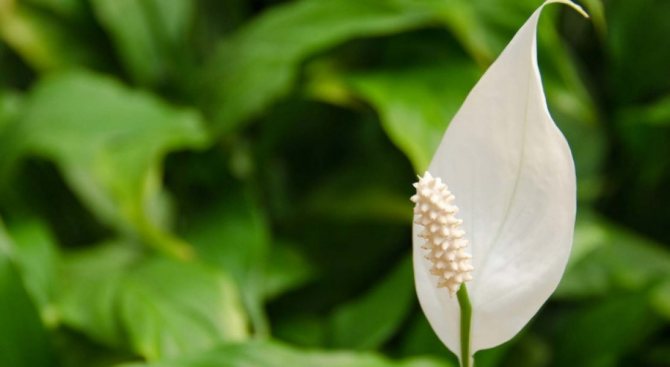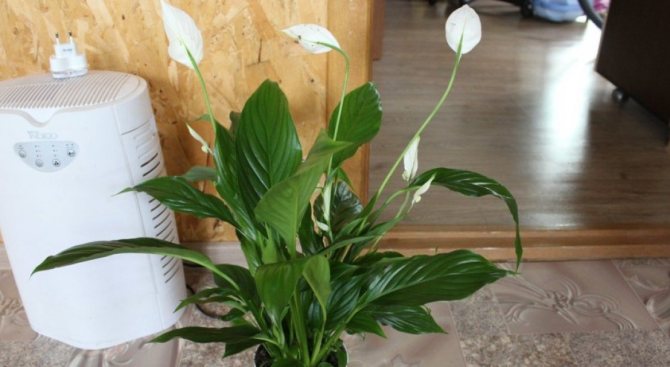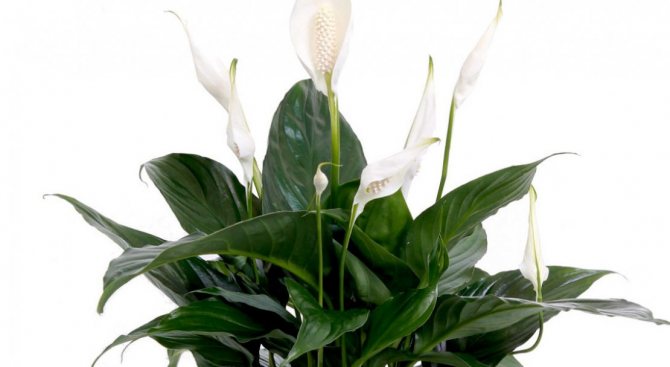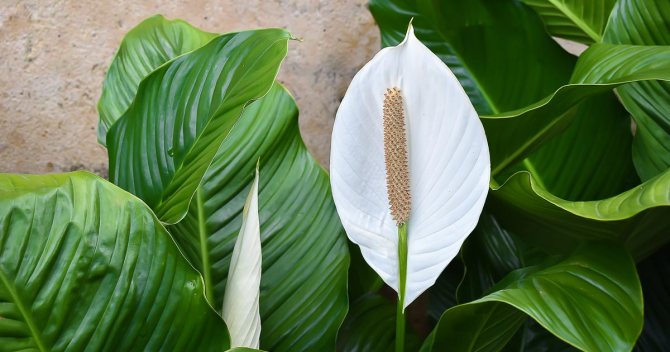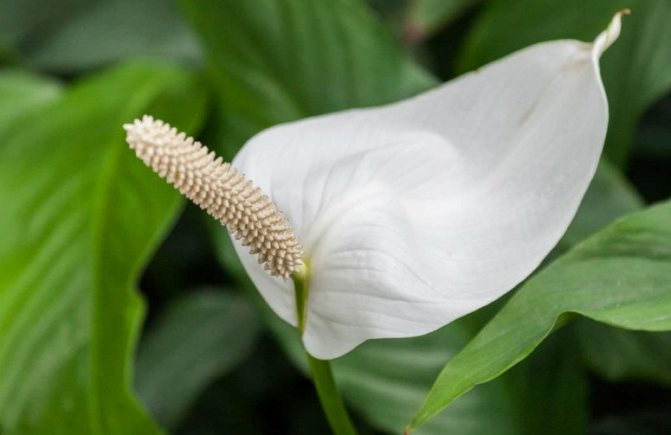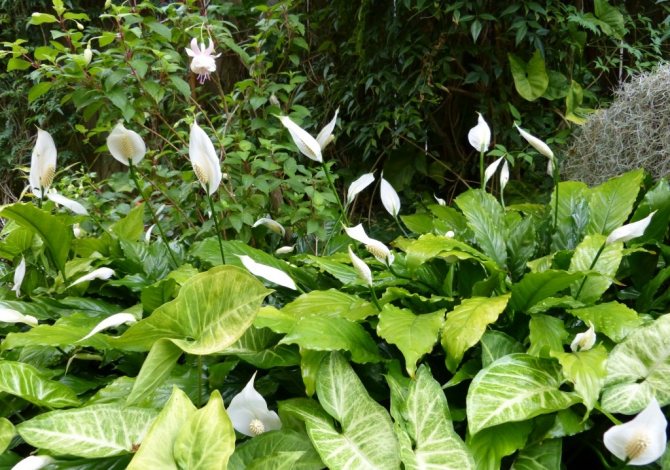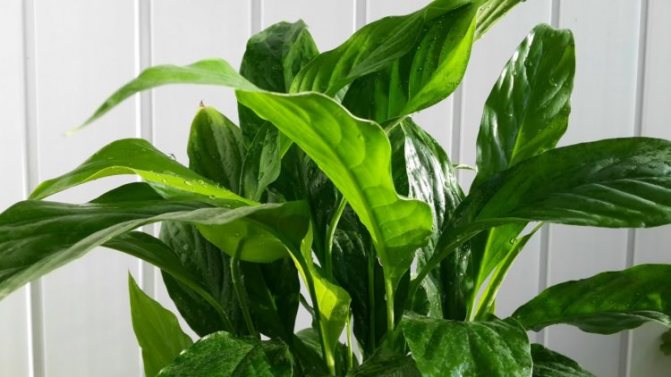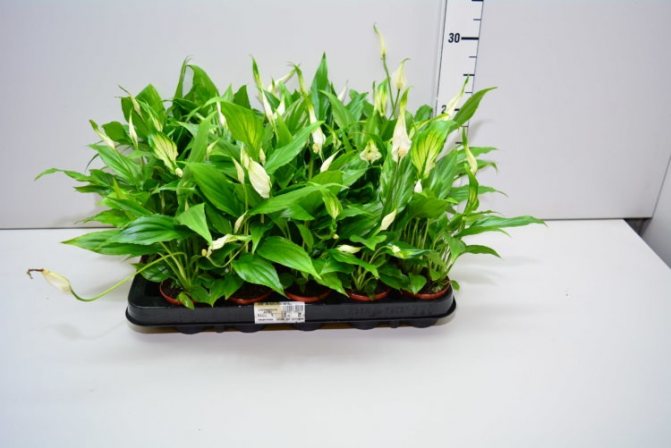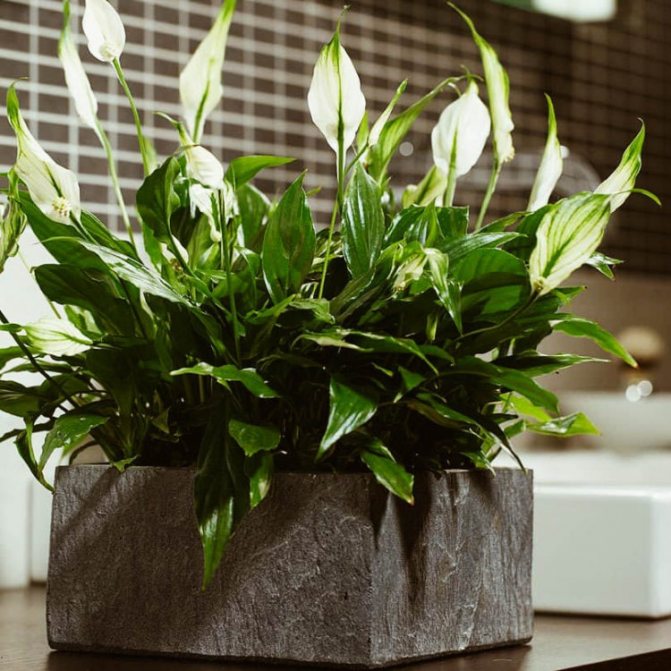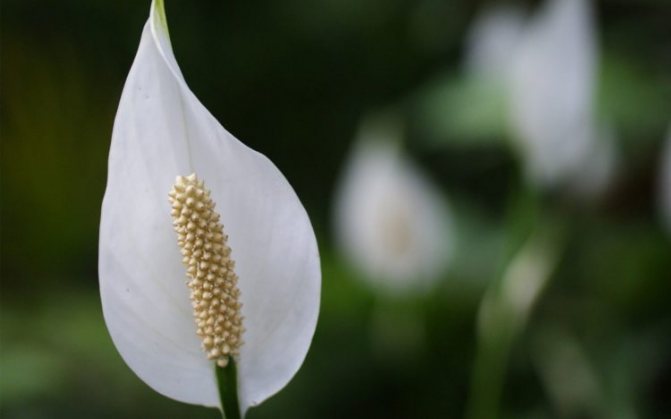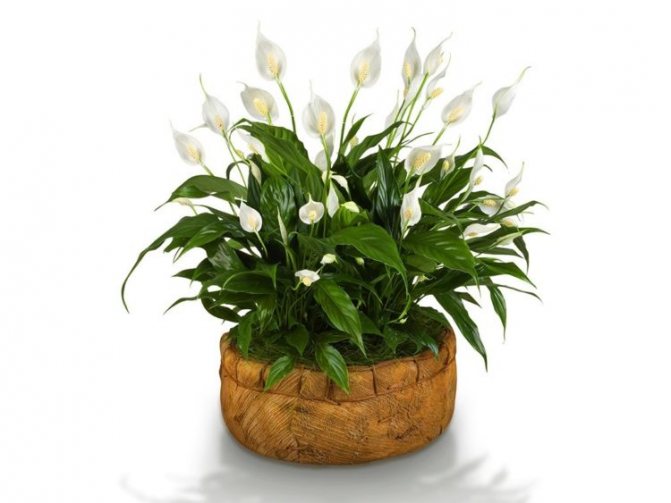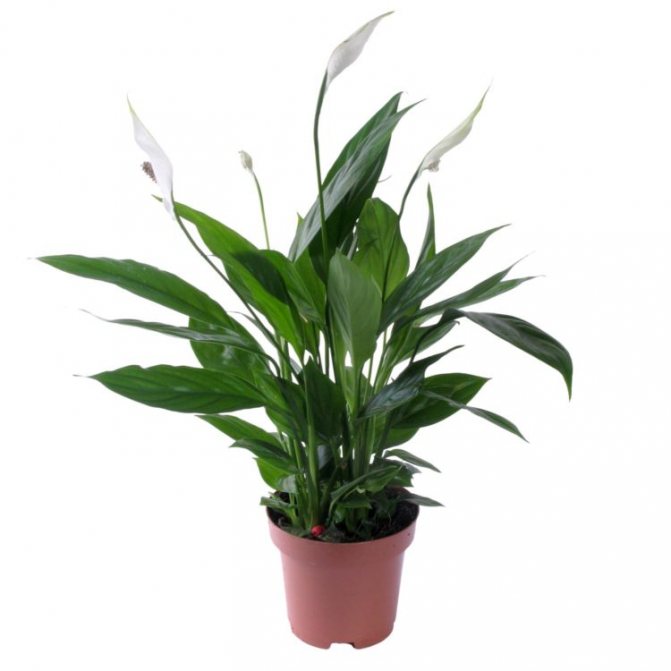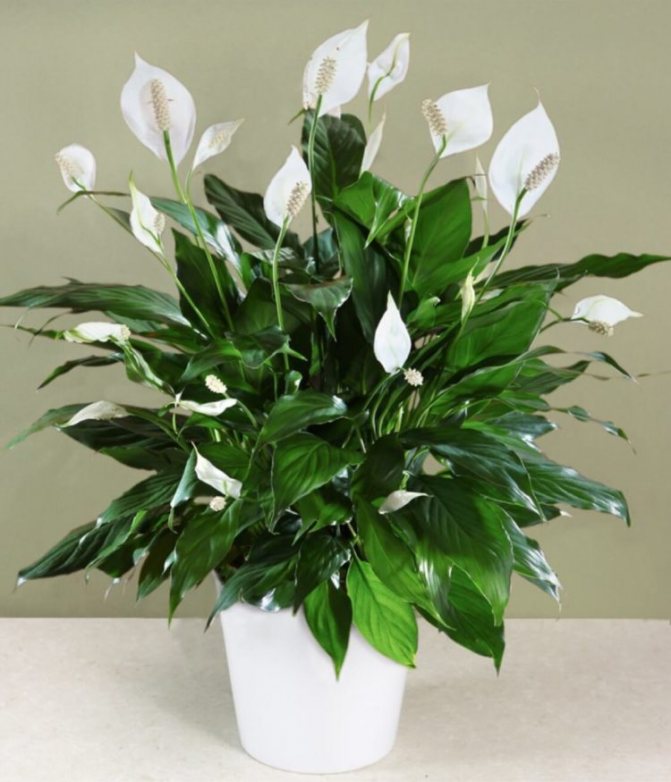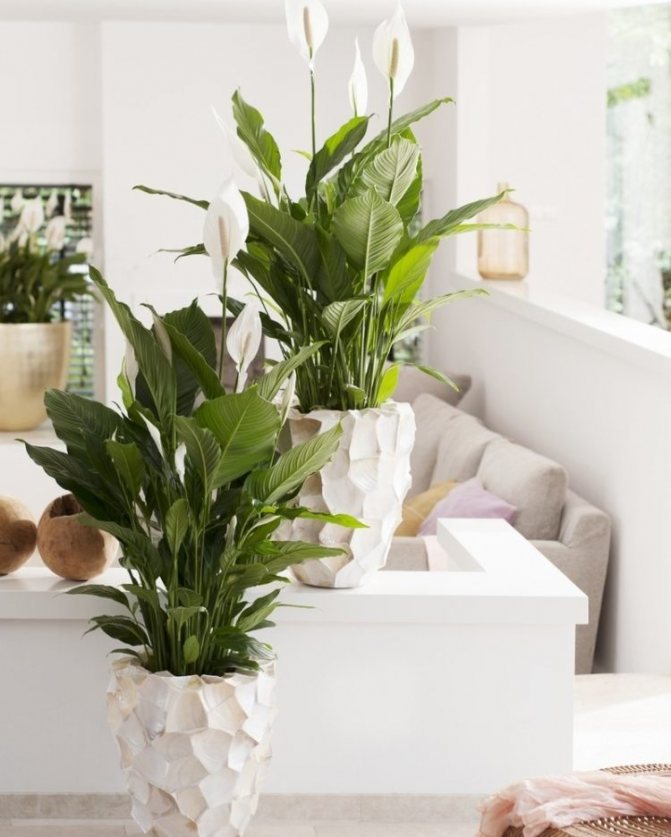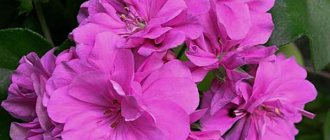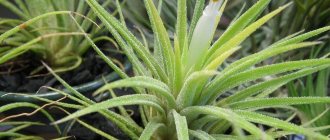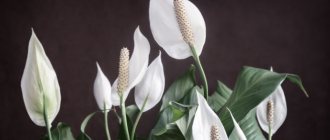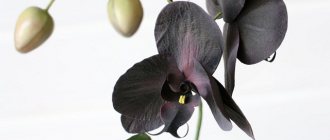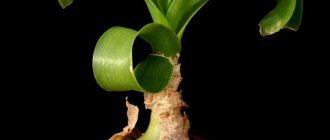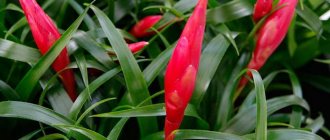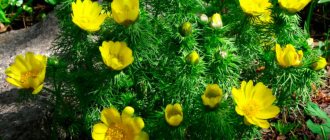A short indoor perennial plant, Latin name Spathiphellum Chopin, obtained by crossing Wallis spathiphyllum with other species. Its predecessor, Wallis' spathiphyllum, was brought by the scientist Wallis from Venezuela, and with the help of selection work, a new species of Chopin was bred, which is especially unpretentious to habitat conditions.
The second name of the plant is Chopin, derived from the pronounced Latin name. Another name for the plant is "female happiness" - for support and help in the lives of women and girls, according to esotericists. For the plant to really help, it is advisable to receive this flower as a gift.
Description of the variety
This evergreen exotic stepped into the comfort of our apartments right from the jungle of Colombia - and for a long time, already in the 19th century. And its Latin name (Spathiphyllum Wallisii, with the correct Latin sounding "spathiphyllum") was given in honor of the German botanist Gustav Wallis, who literally dug it out there and described it for the first time.
The mention of the wet-swampy undergrowth of the tropics of Colombia is not accidental: in order for the plant to feel at home even under the concrete “sky”, the conditions for “female happiness” should be created close to natural ones.
Where the popular name of the genus Spathiphyllum came from is not exactly known. Most likely, due to the shape of the inflorescence: the white bracts overshadows the cob-core like a veil - the bride. And although it is in this that the Chopin variety of spathiphyllum is no different from its counterparts, nevertheless ...
The patriarch of the species, Spathiphyllum Wallisii, is distinguished by:
- comfortable for an apartment with a height of 30-40 cm;
- an elongated shape of pointed 20-24 cm leaves with long, flexible, eventually curving petioles, which causes the leaves to bend;
- white or greenish "sails" of the cobs, completely turning green as the seeds ripen;
- inflorescences of a pure white or cream tone not exceeding 3-5 cm in length, then completely turning green;
- flowering not all year round (only from spring to autumn).
The Chopin variety has significant and pleasant differences from the great-grandfather in the form of:
- more shiny, rich green leaves with sharper tops;
- a much more elongated bedspread of the purest white color with a green pointed tip and equally green veins.
Spathiphyllum "Chopin" in the photo:
The sophisticated, sophisticated scent that emanates from a flower for up to half a day is also a powerful argument in favor of finding a plant in the house. And the last dot above the "and" in the matter of acquiring a copy of this variety is its ability to absorb negative energy and harmful substances from the air of a home or office (common, however, for the entire Aroid family).
It would seem that everything, what is more? But no! In Holland spathiphyllum “Chopin Rondo Yellow” was bred (see photo). With a standard height for this type of spathiphyllum, not exceeding 35-40 cm, it has an absolutely incredible rich yellow color of the bedspread with a green central vein (more distinct on the wrong side) and an equally yellow color of the cob in the center.
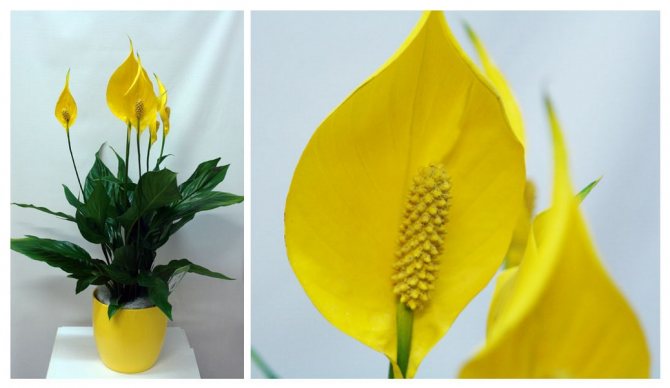
Detailed characteristics and appearance
Spathiphyllum picasso is a perennial evergreen that belongs to the Aroid family.The native land of the species is Central and South America; the plant is also found in Brazil and the Philippines.
The most optimal habitat is the humid climate of swampy forests, near the banks of rivers and lakes.
What it looks like: description and photo
Picasso is a hybrid variety that was bred in the Netherlands. It reaches a height of 45-50 cm. The stem is completely absent, the leaf plates grow directly from the root, forming a basal rosette.
Leaves are fat, with a characteristic shine, reaching a width of 20-25 cm. The density of the plates is average, at the ends they taper. The color of the leaves is heterogeneous - rich green intertwined with white blotches. The cuttings are long, bend well. The color has a sail-like shape. The shade of the bud is white with a delicate green splash. At the base, the flower has a slight yellow tint. The roots are short.
Below you will see a photo of the flower:
What is the difference from other species?
The main distinguishing feature of Picasso is the extraordinary color of flowers, in which light green is intertwined with white. Indoor plants grow sprawling and do not differ in particular whimsical care.
The decorativeness, unpretentiousness of spathiphyllum make this plant indispensable for landscaping offices, apartments, winter gardens. In our articles you will find photos and descriptions of all types and varieties of flowers: Silver Cupido, Chopin, Domino, Sweet Chico, Alana, Sensation, Strauss, Wallis and red.
Plant care
For spathiphyllum "Chopin" home care is as simple as a transplant.
The place for the bush should be light, but without deadly direct rays, the optimum temperature is from 21 to 23 ° C (not lower than 18 ° C). Drafts must be excluded.
During winter watering, the earthen clod should be moist to reasonable limits, in summer - watered ad libitum, but also not until fermentation. A quarter of an hour after watering, the water that has flowed into the sump should be drained.
Additional moisture is achieved by regularly spraying the leaves (remember the semi-swamp origin of the species).
Fertilization during the flowering period requires frequent - every week, either with the composition "For flowering crops" or with a universal complex (potassium and phosphorus are especially needed). During the period of a decrease in the activity of the plant, fertilization is sufficient after 2-3 weeks, in the dormant phase - to exclude feeding altogether.
In order to avoid the weakening of the flower, do not bring the pot with it in winter - to heating devices, in summer - to an air conditioner.
General care consists in basic hygiene:
- removal of dried leaves, wilted flowers;
- washing away dust with a warm shower;
- removing the salt crust from the surface of the pot (if necessary, replacing the upper layers of the soil).
Flowering and feeding spathiphyllum, video:
Where to buy Chopin? How much is?
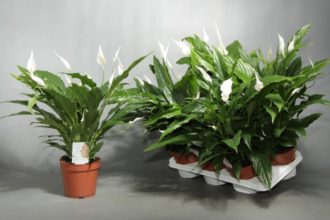

You can buy Chopin spathiphyllum in a flower shop, or through an online store. The cost of a flower is determined by the age when the flower is planted - a seedling or an adult plant.
A flowering plant with a pot of 15 centimeters, will cost from 250 rubles or more, a small seedling in a 9 cm pot costs from 180 rubles. You can just buy a seedling, it costs less - from 50 rubles.
Diseases and pests
As such, spathiphyllum does not have diseases, it suffers only from improper care, the tactics of which should be determined by the behavior of the flower.
So, the absence (complete or shortage) of feeding will be expressed by a single flowering, while a fully fed culture blooms all season. The drooping of the leaves indicates a lack of moisture, rotting of the roots with wilting of the leaves - about hypothermia and overmoistening.
Soil that is too dry will lead to drying out of the edges of the leaves, excessively moistened - to their yellowing, while brown spots on the leaves, their black tips are a sign of overfeeding with nutrients.
Like any culture grown in artificial conditions, the flower is more susceptible to pest activity than in the wild:
- mealybugs;
- thrips;
- spider mites.
Getting rid of them is done either by mechanical (by hand) removal of pests, or by the same means as for other plants:
- Aktellik;
- Karbofos;
- Decis.
It should be remembered: only true friendship with a plant, attention to its needs can lead to its neat appearance, health and full-fledged long flowering.
Reproduction
Spathiphyllum can be propagated by cuttings or by dividing the bush when transplanting.
Propagation by cuttings
For the cutting, a rosette of a plant with several leaves is chosen, which is cut off almost from the root, keeping the junction of the leaves. You may have to bury the knife into the soil a centimeter and a half in order to properly separate.
Germinate in wet sand or a glass of water. Several pieces of activated carbon are placed in a glass of water to prevent water bloom and decay.
Rooting requires a temperature of + 22 ° - + 25 ° and light. To ensure constant comfortable conditions, the cutting is covered with a bag to create greenhouse conditions. Ventilate periodically.
After the appearance of roots of a few centimeters, the young plant is planted in ordinary soil.
For better survival, you can cover the plant with a bag for several days, periodically airing it.
Reproduction by dividing the bush
By dividing the bush, spathiphyllum is propagated during transplantation. When dividing, there should be enough roots, at least two or three leaves and a growth point for new leaves. New plants are immediately planted in suitable soil.
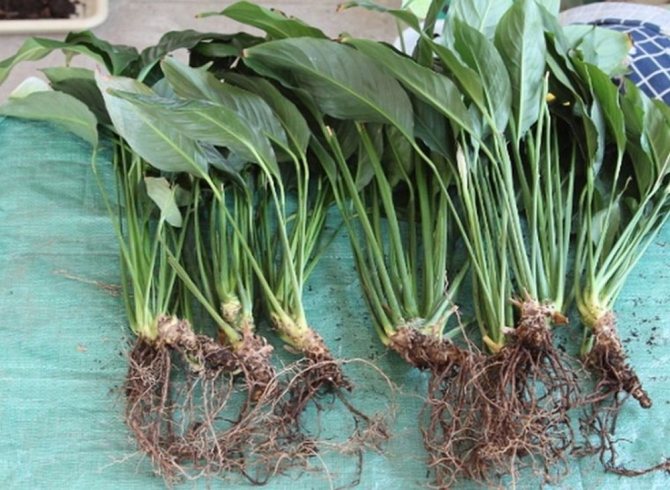

Spathiphyllum reproduction
Botanical description
In general, with regards to this plant, there is a very interesting and beautiful symbolism: a beautiful flower also bears the glory of "female happiness". An old belief says: young girls and unmarried women who grow this plant at home should not give the flower to anyone. There is an opinion that by passing it on to someone, they give this person their happiness. At the same time, careful and painstaking care of a representative of the flora, as they say, will help not only achieve its abundant flowering, but also find good luck in personal relationships. Probably, according to this superstition, there is a tradition to give this interesting indoor flower not only to unmarried young women with a wish to find their soul mate, but also to still childless wives with a pregnancy blessing.
The homeland of the wild ancestors of spathiphyllum are the tropical regions of America and East Asia. According to phytological criteria, the plant often grows directly from the soil, but among some species there are also those that develop their vital activity, attaching roots to other representatives of the flora.
Important! If you strictly adhere to all the recommendations for caring for the plant, the latter will delight you with its continuous flowering for about six months (mainly from the beginning of spring to the beginning of autumn). According to scientific data, there are approximately 40-45 species of this plant, but today the indoor variety of spathiphyllum "Chopin" or "Chopin" is gaining popularity among those who are engaged in growing flowers at home, as well as caring for them. This evergreen perennial is characterized by long, elongated and dark green leaves, with the cuttings expanding at the base of the leaves. The latter, being collected in a bunch, and having specific squeezed "veins" in their surface, originate not from the stem, but from the soil itself. The underground part of the spathiphyllum shoot is short.In addition to spathiphyllum, lovers of unpretentious indoor plants should pay attention to sansevieria, chlorophytum, tradescantia, cacti, euphorbia, hoya, zamioculcas, hibiscus, Christmas tree.
Inflorescences of snow-white color with a stamen inside, located on light green leaf covers, have a very enticing appearance and a pleasant smell, more pronounced in the morning and almost imperceptible in the evening. The first flowers of a young plant appear upon reaching the age of six months. The parameter characterizing the size of the plant is the height that the spathiphyllum reaches - within 50-70 centimeters.
Description and photo
The plant is 35 centimeters high, leaves are rich green, glossy. They have an oval shape, completely extreme, with well-visible veins, because of which the leaf seems to be wavy and with a pointed end, 20-25 centimeters in length, and up to 5-6 centimeters in width, collected in a basal rosette. They are planted on green petioles up to 18-20 centimeters, widening at the top and coming out almost out of the ground. The flowers are light cream in color, collected in an inflorescence of a cob, covered outside by a white, slightly elongated perianth.
Chopin differs from other types of spathiphyllums in a pleasant aroma of flowers - saturated in the morning and decreasing in the evening.
Conditions for "female happiness"
The beautiful appearance of a plant in a greenhouse is an indicator of proper care and compliance with conditions suitable for this particular representative of the flora, as well as recommendations for its maintenance. That is why, like any living being, spathiphyllum needs specific norms for successful development and growth, as well as flowering in the process of many years of life. Next, we will figure out the peculiarities of the flower-symbol of "female happiness", as well as how to care for it so that it blooms in a timely manner and for a long time.
Did you know? According to social surveys, in families with frequent "debriefing", quarrels and scandals, spathiphyllum does not survive, and, at first, withers, and then dies altogether.
Humidity and temperature
The best air temperature for the well-being of the plant ranges from + 18 ... + 25 degrees. At the same time, such a level should be monitored both in the cold time of the day and in the warm, when, for example, at night the windows can be opened for ventilation. The plant is thermophilic enough, so its potential hypothermia should be avoided. It should be noted that at this temperature it is also worth taking care of sufficient air humidity, the indicator of which is 40% is absolutely safe and most acceptable for spathiphyllum. To achieve this goal, it is recommended to spray the plant every couple of days in the summer. When spraying, it is necessary to ensure that the sprayed water does not fall on the buds and inflorescences, for this it is better to cover the latter for the duration of this process. An important point in plant care is to control the purity of the leaves, this is necessary not only for aesthetic purposes, but also to prevent damage to the plant by various bacteria and other pests. For hygiene purposes, the leaves should be regularly wiped with a damp sponge every 10 days or 2 weeks.
Lighting for a flower
The east or south side is the most suitable place in an apartment or house for spathiphyllum.
Important! A plant of this genus is very afraid of sunburn. It is worth making sure that the light recharge is of a diffuse type. Although the flower tolerates shade or partial shade well, it should still be provided with a satisfactory amount of lighting, since its lack reduces the picturesqueness of the flower. The optimal place will be the window sill of that window, towards which not direct sunlight is directed, but diffused light falls.
Soil requirements
The soil in which the shoots are located should be normally moist, but not too damp, since stagnant water in the roots can lead to unpleasant consequences, up to the death of the flower. A good soil for spathiphyllum will be a mixture of an ordinary substrate with brick and charcoal chips or a universal soil with a peat mass of no more than a quarter of the total volume.
Features of spathiphyllum
The genus Spathiphyllum includes perennials that are stemless. Their leaf plates grow from the very root and can be oval or lanceolate. In spring, flowering begins, an inflorescence appears on the bush, which is an ear covered with a blanket. When the bush has faded, cut the stem as low as possible.
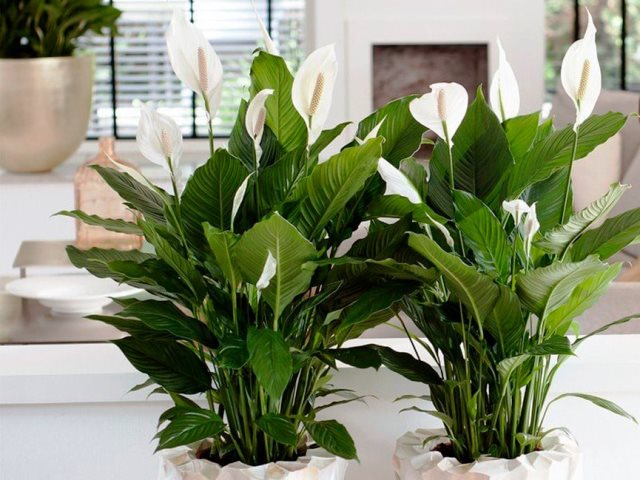

Such a plant is very popular with flower growers, because during cultivation in indoor conditions, it is undemanding in care. It also has decorative leaf plates, which also contributed to its high popularity. Although this flower is considered unpretentious, but in order for it to grow and develop normally, it must be watered abundantly, and also maintain a high humidity in the room.
Chopin spathiphyllum care
Comprehensive care of a flower includes its regular watering, systematic replenishment of the soil in which the plant develops, as well as its annual transplant.
Important! Do not be afraid to remove wilted flowers, after cutting old ones, new and healthy ones will appear faster.
Watering
Moistening the soil in the spring and summer is the most important rule that novice growers who decide to grow spathiphyllum in indoor conditions must observe. But at the same time, it must be remembered that this process must be carried out with such frequency that there is neither drying out of the soil, nor an overdose of liquid. In the autumn and winter, watering should be reduced. The interval between summer and spring irrigation should be within 2-3 days, and in winter and autumn - 7-8 days. The level of water hardness should be minimal (spathiphyllums, like other plants, like soft liquid), and the temperature should be at room temperature.
Fertilizer
The most important step in caring for the Chopin variety of spathiphyllum at home is feeding. Nutrition with fertilizers with bird compost or mullein will help the plant develop better and faster, it is only recommended to take into account the fact that for better absorption of the nutrients contained in these products, the plant must be provided with abundant watering. Some store-bought fertilizers, which are suitable for use in the spring and summer, have a liquid consistency (according to the instructions, they must be diluted in such a proportion so that they are at a reduced concentration). Such funds are suitable for weekly feeding of spathiphyllum during its active growth and flowering after abundant watering with clean water. The appearance of dark brown spots indicates that the plant is oversaturated with nutrients, in which case the feeding should be suspended.
Transfer
In the spring of each subsequent year, spathiphyllum is recommended to be transplanted into a slightly larger pot. As with transplanting any plant, be careful with the root system, since the slightest damage to any of its components leads to the inevitable death of the flower. Young plants must be transplanted annually, and starting from the age of four, the frequency can be reduced to one movement for 2-4 years, depending on the health of the plant. It is better to transplant a very small young spathiphyllum together with an earthen lump, since it is at this age that the roots of the flower are still very fragile and thin.
Did you know? In the plant world, there is a flower similar to spathiphyllum from the same family, but with red flowers - Anthurium Andre. On the contrary, it is called "male happiness", and experienced gardeners often put them together as a symbol of unity, understanding, support and a happy union.
Landing
In order to properly plant a plant, it is imperative to select a pot, its size cannot be larger or smaller. The pot should be 3-4 centimeters larger than the roots of the spathiphyllum... Need to:
- Put expanded clay at the bottom, sprinkle with a little nutritious soil.
- Place the seedling in a pot and hold, fill the soil up to the edges of the pot.
- Lightly crush and water.
Soil for planting indoor flowers can be purchased at the store, or you can prepare it yourself. To do this, mix in equal parts leafy soil, turf, peat, sand.
Seeds
To plant a plant with seeds, you must prepare a pallet, or a container with a wall depth of no more than 3-4 centimeters. Step by step instructions for growing spathiphyllum from seeds:
- Pour prepared soil into the prepared container, having previously calcined it.
- Spread the seeds, or manually press the seeds into the ground. Pour everything, cover with specially prepared transparent glass, and put on the windowsill.
- Continue watering, and sometimes airing, avoiding waterlogging and the appearance of mold.
- After sprouting, continue watering and airing until the sprouts are 3 centimeters high.
- Plant the seedlings in small cups, continue watering.
- When the seedlings reach a height of 6 centimeters, transplant into slightly large cups.
- After 12 weeks, transplant into permanent pots and place in permanent housing.
- After 2 weeks, we start feeding with complex fertilizers.
Features and possible difficulties
In order not to face potential pests or other obstacles in the normal development of the flower, we repeat, it is necessary to properly care for the plant and remember that the best solution to the problem is its prevention.
Important! In the process of caring for the plant, flowers can be cut for bouquets, and the inflorescences themselves can be preserved for a whole month. From a number of insects, spathiphyllum can damage aphids and scale insects. The way to combat them is to wash the sheets with soap, provided that the soap solution does not get on the soil (for this, the substrate is often covered with cling film). After doing each procedure, which must be repeated several times with a break of several days, the plant is washed under a light shower. If the leaves have changed their color:
- yellowing of leaves in an adult plant is a normal process of dying off old leaves (they need to be cut off);
- if the leaves of a young spathiphyllum turn yellow, especially after a long flowering, the reason may be a lack of fertilizer or watering;
- blackening: insufficient air humidity / burning leaves in direct sunlight / excessive soil moisture / lack of nutrients.
The reason for the lack of flowers in a plant may be an incorrect location or too large a container in which it is planted. Often the tips of the leaves of spathiphyllum begin to dry, even if you do not neglect the norms of watering and spraying the plant. Dry air may be the culprit: in this case, a tray of water or wet moss can solve the problem.
Did you know? Indoor plants can have an inexplicable effect on our health and well-being, as well as on our mood and the general atmosphere in the house. They can be both wonderful friends for us, and they can hide hostility and hostility behind their beautiful appearance. For example, orchids, simply amazing in appearance, have a truly vampire character.It is not recommended to put them in a room where people sleep, because it is at night that they feed on energy and affect a person's temperament.
In general, the plant is not very whimsical, and like any living creature it requires care, affection and attention. If you strictly follow the recommendations of experienced florists, you can enjoy the decoration of your interior, its flowering and aroma throughout the year.
Brief description of spathiphyllum
The peculiarity of this flower is that it practically has no stems. Its lanceolate-oval leaves grow straight from the ground. Arrows with unusually graceful flowers also emerge from there. Some people think that the white sail is the flower itself. But this is not the case. It only serves as a "beacon" for pollinating insects. The flower itself resembles an ear of corn, around which a white blanket is located.
Dangerous properties of the plant
The petals form dense, bright green thickets. They are oval, slightly pointed, with well "squeezed out" veins. It must be remembered that spathiphyllums are poisonous, since their foliage contains calcium oxalate, which can irritate the gastric mucosa and irritate the eyes. The substance begins to bake in the mouth, saliva is actively released, and a burning sensation may appear in the respiratory organs. Therefore, when working with a flower, it is better to use gloves or wash your hands well afterwards.
Useful properties of the plant
Despite the poisoned sap flowing through the veins of the flower, it has a lot of useful properties. For example, it is able to clean the air of the room from harmful substances that penetrate into the home from the environment. In addition, some toxic elements released from the finishing materials after renovation are also removed by the flower.
A flower with phytonicides is a panacea for many diseases
Another indisputable advantage is its high phytonicidal properties. Phytonicides are special elements secreted by plants that can destroy pathogens and fungi that are in the atmosphere. Therefore, it is recommended to place it in rooms with a moldy smell or in rooms with high humidity, where there is a risk of this problem.
How to properly transplant and propagate spathiphyllum
A young spathiphyllum is usually transplanted annually. After five years, the plant should be transplanted into a slightly larger container, when roots appear in the hole at the bottom of the pot.
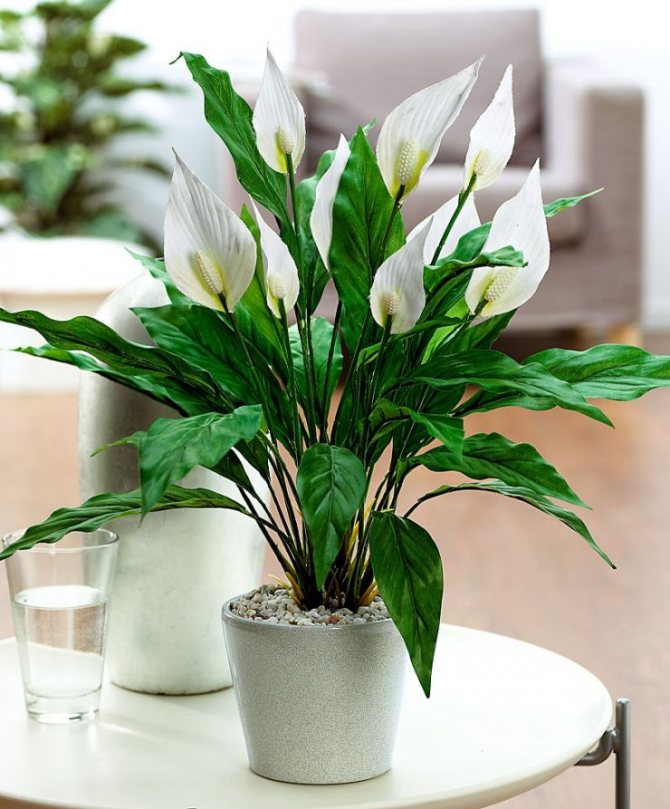

It is better to choose a shallow pot for planting to avoid soil acidification even before rooting. And when transplanting, it is reasonable to take a new container of a slightly larger volume than the previous one.
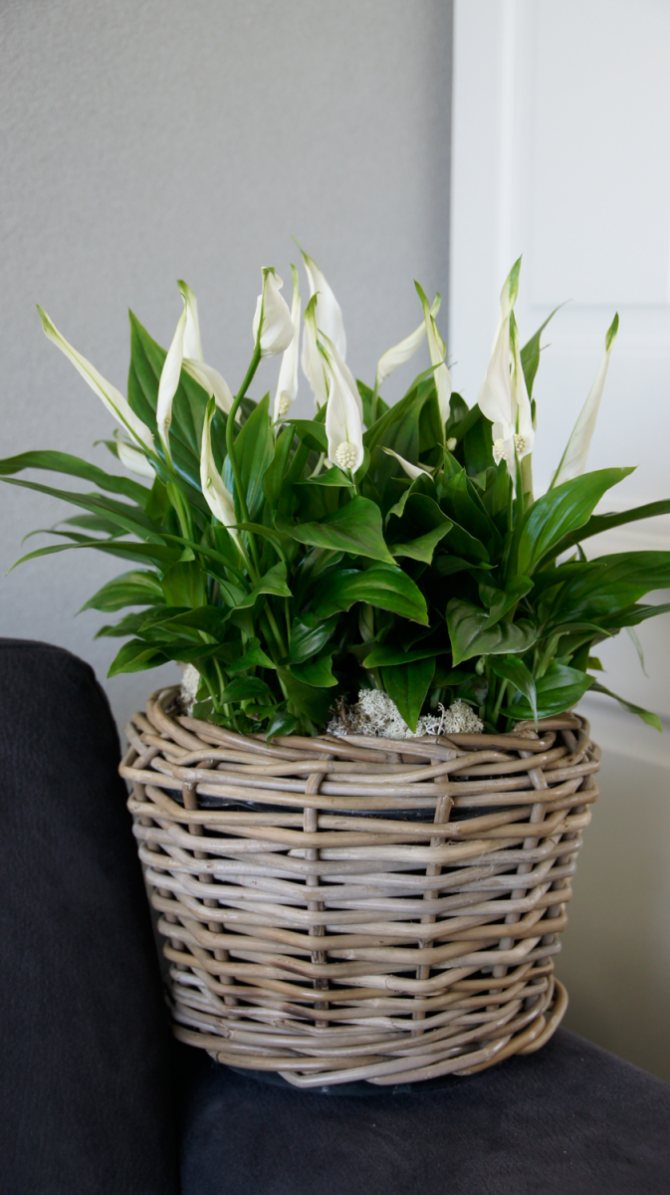

It is wise to water the plant thoroughly before transplanting, then remove the side shoots. So the spathiphyllium will be larger, as can be seen from the photo.
The flower should be planted in new soil directly with the old earthen clod, then the void of the pot should be filled with a new substrate.
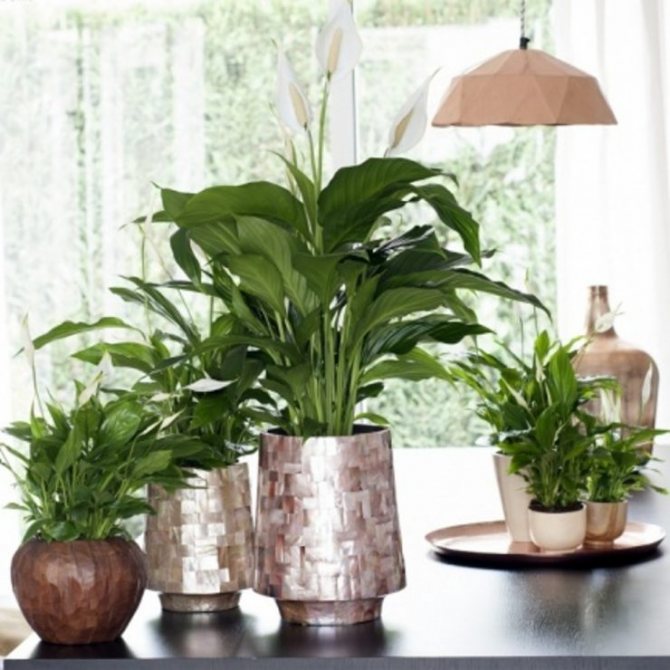

After the spathiphyllium is transplanted, it is not worth spilling the earth for two to three days, because this way the plant takes root better in a new place.
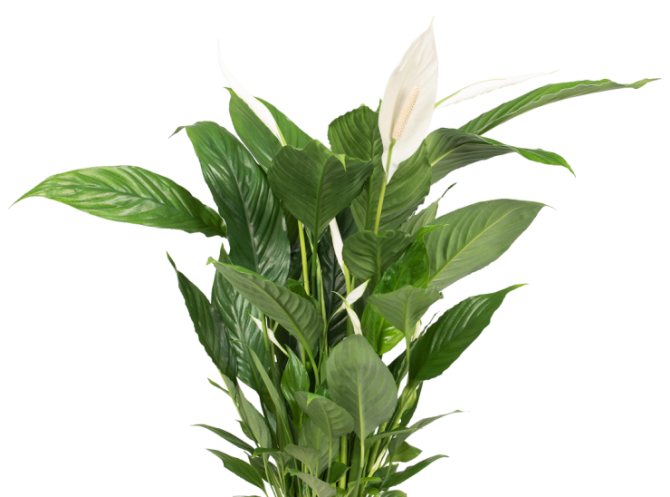

Florists recommend propagating a flower by dividing a large bush in the spring:
- the processes are carefully separated from the sides along with the root system, trying not to harm it;
- shoots are planted in fresh soil.
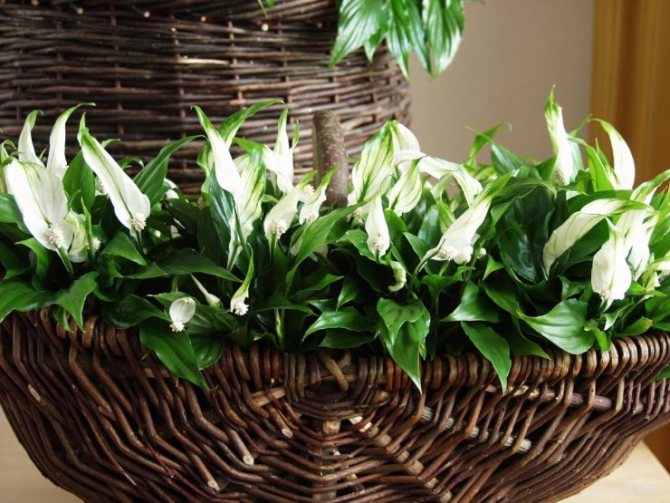

Spathiphyllium can be propagated by seeds. In practice, it has been proven that this occupation is quite time consuming and has low efficiency. In addition, it is not a fact that the desired variety of a given plant will grow.
Spathiphyllium, like any other houseplant, requires regular feeding. From the beginning of spring until the beginning of autumn, it is necessary to apply mineral fertilizers once every three weeks.
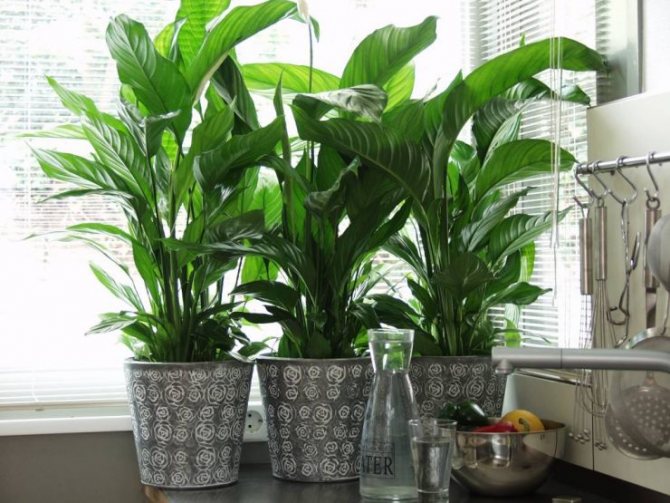

When the flower retires, you should stop feeding, or, if abundant growth continues, fertilize it up to once every 30 days.
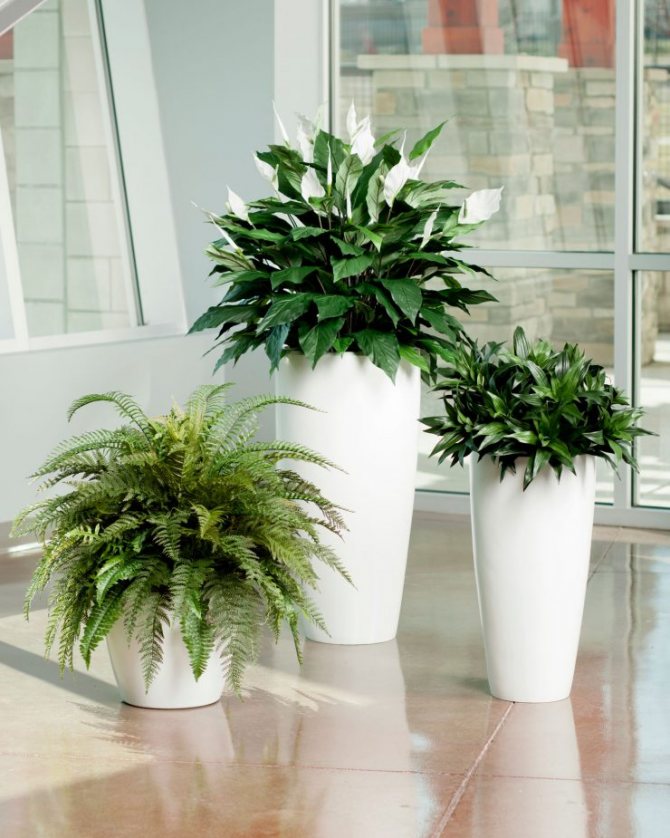

Step by step care instructions
Seat selection
Spathiphyllum Picasso loves good lighting.But the sheet plates should not be exposed to direct sunlight. Therefore, it is best to stir the pot on the southeast or east sides of the room. If you are placing the flowerpot on a southern windowsill, protect the plant from the sun's rays. To do this, hang sheets of paper on the window.
In the autumn and winter periods, additional lighting is required (2-3 hours a day) - phytolamps are best suited for this.
What should be the soil?
The soil for Picasso's Spathiphyllum needs to be selected lightweight, breathable and permeable. The substrate must be regularly loosened, fertilized and moisturized. The most optimal soil composition:
- peat;
- bark (preferably coniferous trees);
- sand (coarse is needed, so it is better to take river sand);
All of this is taken in the same proportions.
Landing
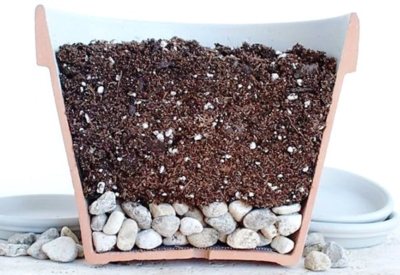

It is necessary to transplant the plant in early spring, when its flowering has not yet begun. Planting instructions:
- place a drainage layer on the bottom of the pot (its height is 1.5-2 cm);
- up to half of the flowerpot, the substrate described above is poured;
- the plant is laid, while the roots are spread over the entire surface of the soil with gentle movements, the processes are pressed with light pressure;
- the remaining soil is poured on top, tamped;
- water well and wait for the soil to settle;
- add soil to a full pot;
- leaf plates are sprayed;
- for the first five days, the seedling is stored under a cellophane cover.
Temperature
Spathiphyllum Picasso belongs to heat-loving plants. Lowering the air temperature to 10 degrees and below can lead to diseases of the flower or its death. The optimal temperature regime is 19-21 degrees above zero. In summer, if the air warms up more, spray the plant to cool the plant.
Watering
This type of plant loves moisture, so the soil in the flowerpot should be moistened all the time. Air humidity is also an important factor - it is kept at the level of 40-50%.
You need to water twice a week, while pouring water abundantly. It is impossible to moisten the soil often and in small portions. In winter, the frequency of watering is reduced to once every seven days.
For additional humidification, place a container of water next to the flower pot. As it evaporates, it raises the level of humidity in the air.
Spray the bush daily. Once a week, wipe the leaf plates with a damp cloth - this will protect the leaves from dust accumulation that causes flower diseases.
Reference! For irrigation, it is better to use settled water (you can also take clean rainwater or filtered).
Top dressing
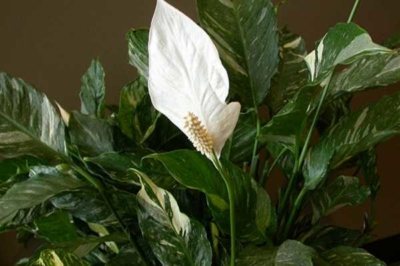

In the spring and summer season, Picasso's spathiphyllum needs intensive feeding. We recommend using complex fertilizers. It is better to buy ready-made in a specialized store. Top dressing is applied in small doses - 1-1.5 g per liter of water is enough. Fertilizers are introduced along with water so that beneficial elements reach the root system.
When the plant begins to bloom, feeding is stopped. For better flowering, Picasso is fertilized with potassium and phosphorus (taken in equal proportions).
You can use organic fertilizers - bird droppings. It is brought in in small portions once a month.
Pruning
As soon as the buds have faded, the peduncles are immediately removed - this is necessary so that the peduncles do not take nutrients from the plant. Cut off dry leaves in a timely manner. Do not forget to remove the affected leaf plates and parts of the root.
After pruning, the cut sites are treated with crushed charcoal - such a manipulation will protect the plant from infection.
Transfer
A transplant is necessary for Picasso's Spathiphyllum if the roots have grown strongly. This is done at the very beginning of spring before flowering.
Transplant algorithm:
- The old soil is moistened, it is allowed to brew for soaking.
- After that, the rhizomes are removed from the flowerpot and cleaned of old soil.
- The roots are examined, if there are rotten and dry ones, they are removed.
- A drainage layer 1.5-2 cm high is placed on the bottom of the pot.
- Sprinkle with earth (height 2-3 cm).
- Place the plant in a flowerpot and sprinkle it with earth until it is completely filled.
- Water the flower a little so that the earth is compacted, then add more soil.
- In the first week after transplanting, cover the leaves with plastic. At the same time, take it off daily for airing.
Aerial roots do not need to be deeply buried - they will serve as an additional support for the plant.
Plant basics
Very often, concepts such as happiness and flowers are combined with each other. Probably, many have noticed how people's eyes begin to glow with happiness at the sight of a beautiful flowering plant. And on some happy or memorable day, a presented bunch of even the most modest flowers can always warm the soul. According to folk legends, flowers can not only become a decoration for living quarters, but also bring happiness.
One of these natural wonders is called spathiphyllum. The proof of this statement is the second name of this plant - "Women's happiness". In natural conditions, this "Happiness" can be found in tropical forests. The word "phill" in translation means "leaf", and "spati" is a veil, based on this, the name of this representative of the green world appeared.
The leaves of the plant are basal, long, bright green, shiny. Inflorescences are white. Spathiphyllum blooms for a very long period, especially in spring. The beauty of flowers will delight for several weeks in a row, twice a year, with proper care.
To continue the conversation about this flower, you need to talk about how to transplant it, what time to do it, and, especially, in which pot it is better to place it.
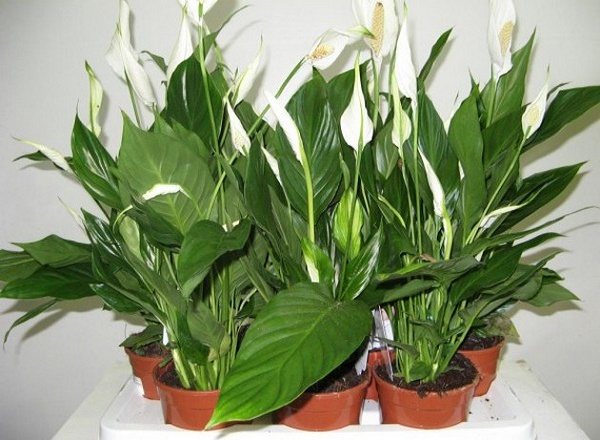

"The Scarlet Flower" - Truth or Fiction
Sometimes flower growers try to find red spathiphyllum on the shelves, confusing it with another representative of the Aroid family - anthurium. The fact is that all representatives of spathiphyllum are characterized by a white petal-sail, sometimes with greenish veins or blotches. After flowering, they can turn bright green, but they can only be made red with the help of coloring chemistry.
Anthurium externally and in many botanical characteristics is indeed very similar to spathiphyllum. It is its funnel-shaped petals that wrap around the ear that lead to confusion. They are red, burgundy, pink, purple, orange, sometimes multi-colored. Unlike spathiphyllum, which is considered the flower of female happiness and family well-being, anthurium symbolizes masculinity and strength. They are often kept together, as their care overlaps in many ways. In addition, it is believed that such a cohabitation of flowers leads to harmony in the family.
Mini varieties of culture
In the course of selection, a tiny variety was bred, the so-called spathiphyllum-mini or dwarf, its height does not exceed 15 cm.
Spathiphyllum Strauss can also serve as an example of compact flowers, the foliage of which does not outgrow above 30 cm. Its leaves are dark green, elongated, dense, reminiscent of well-dressed leather, with a glossy bloom. The flowers are creamy white with a snow-white sail.
The same varieties with miniature volumes of foliage and small flowers include: Macho, Mozart, Quatro. All of them were obtained on the basis of Wallis spathiphyllum, therefore, they have similar characteristics.
Varieties of giants of spathiphyllum
In contrast to miniature varieties, Dutch scientists have created Spathiphyllum Sensation, which is characterized by large and powerful foliage and flowers. In the course of its breeding, the goal was to obtain a large-sized, office plant that would not be afraid of poorly lit, large rooms. In height, it can reach 1-1.5 m.
Its leaves are dark green, oval-pointed, bursty, large, their length can vary between 40-80 cm.The foliage is very prominent due to the deepened longitudinal strip and veins diverging to the sides. No less beautiful are the large flowers - the cobs, wrapped in a white veil of the petal.
No matter how outlandish the giant flower looks, caring for the giant spathiphyllum does not cause any particular difficulties. Creating a hybrid, Dutch scientists have taken care of the simplicity of its content.
Sweet Chico variety
Spathiphyllum Sweet Chico, descended from the Wallis species, also belongs to varieties characterized by large, voluminous bushes. Its average height is 70-75 cm. It blooms with large, snow-white flowers in the form of a cone twice a year. Just like other varieties, it grows without stems, the leaves grow directly from the ground, forming a lush bush. Differs in simplicity of content.
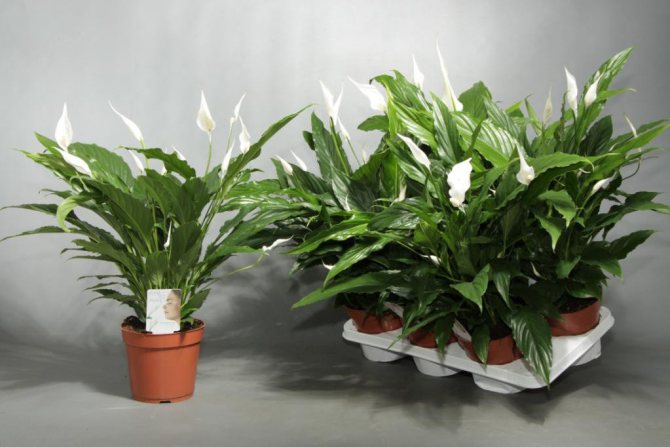

Spathiphyllum Sweet Chico
Variety Cupido
From all other varieties of spathiphyllum Cupido differs in a high "leg" - an elongated petiole, on which shiny, bright, green, embossed leaves are formed. They are elongated and elongated, and on their plane there is an embossed pattern of veins. The flowers are bright white, devoid of all sorts of shades, conical, with pointed ends. The total height of the plant is 50 cm.
Alan's variety
Leaves with elongated cuttings are also characterized by Alan's spathiphyllum. Due to this feature, the foliage does not slope down, as it happens with most plant varieties. The foliage constantly maintains an upright position, which significantly improves the decorative properties of the flower. Outwardly, it is very similar to the Cupido variety. The only difference is that there is a longitudinal green stripe on the back of the white petal. In order for Alan's spathiphyllum care at home to become successful, several simple requirements must be observed, which will be discussed below.
Time to transplant into a new pot
Spathiphyllum is unpretentious to care for as long as it feels comfortable in a pot. But, as a rule, there comes a certain moment when the plant needs new housing in the form of a flowerpot, that is, the moment of transplantation.
A plant transplant, as a rule, is recommended to be done in the spring, in exceptional cases, if unforeseen circumstances arise, it is possible in the fall. The required transplant time is easily determined by the roots of the spathiphyllum. If they completely fill the flowerpot and flowering stops altogether, this will be a clear indication that it is definitely time to transplant.
Plants that are already considered centenarians can be transferred to a new pot once every 2-3 years. Young flowers that are growing rapidly are recommended to do this annually. In some cases, "female happiness" is transplanted, as they say, a pose with a plan, that is, when the land becomes completely unusable. In the soil, which, having changed its structure, has become dense, and the plant does not receive the oxygen necessary for normal development, it is not desirable to continue to contain the plant.
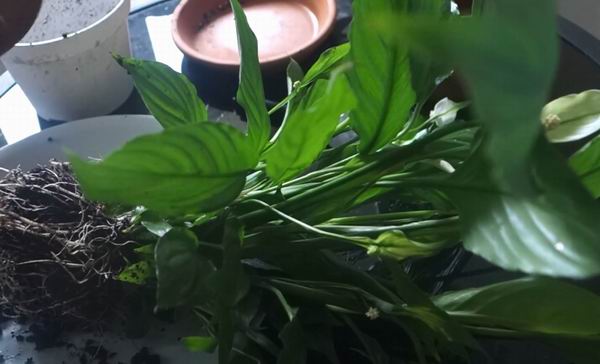

Is the plant poisonous or not?
The plant contains poisonous juice, which can cause irritation and burns of the mucous membrane of the mouth and esophagus, as well as poisoning, and if the owner has a tendency to allergies, then it can cause a strong allergic reaction.
It is recommended that all work on the care, transplanting, pruning of the plant be carried out in protective gloves and glasses.
Allergy can manifest itself in the form of:
- red spots;
- rashes in the form of small red pimples;
- itching and general swelling;
- runny nose;
- The most severe symptom is laryngeal edema, known as Quincke's edema.
To reduce the allergic reaction, it is necessary to take drugs that remove toxins, like activated charcoal, and also take antihistamine tablets. But it is better to see a doctor right away.


Poisoning is manifested:
- rapid breathing;
- heart palpitations;
- severe headache;
- slowing down the reaction;
- sweating;
- general weakness.
To help the victim, it is necessary to call a doctor, or hospitalize the patient in a nearby hospital.
If your pet is injured
Cats very often touch the ground in pots, in winter they often gnaw on leaves. It is worth paying attention to symptoms such as:
- lack of physical activity;
- your pet just lies and does not get up;
- he breathes often and hoarsely;
- the heart beats very often;
- a lot of saliva is released.
You need to give the animal one tablet of activated charcoal at the rate of one tablet per kilogram of weight and take the pet to the veterinarian.
How to choose a pot for spathiphyllum
Before you start to transplant "female happiness", you need to learn how to choose the right pot. What material it will be made of does not really matter, for the reason that the plant does not react to this indicator. The pot can be chosen according to your taste, based on material capabilities. No one disputes that the most beautiful, durable and environmentally friendly flowerpots made of clay are considered, but others are also quite suitable.
The volume of the new pot should be slightly larger than the previous one, but at the same time, you need to know that being in a pot that is too large in size, the plant will noticeably slow down its growth. To ensure regular flowering, it is necessary to keep the roots in a confined space. When the dwelling in the form of a flowerpot for a "tropical household" is too large, the soil will need to be periodically compacted artificially in order to cause the next flowering.
The difference in diameter between the old and new pot should be no more than three centimeters. If spathiphyllum grew in a container with a diameter of 18-20 cm, this is already a sufficient volume and a transplant will not be needed. In this case, it is only necessary to regularly renew the topsoil. When plants are propagated by seeds and cuttings, they should be planted in circles with a diameter of no more than 10 cm.
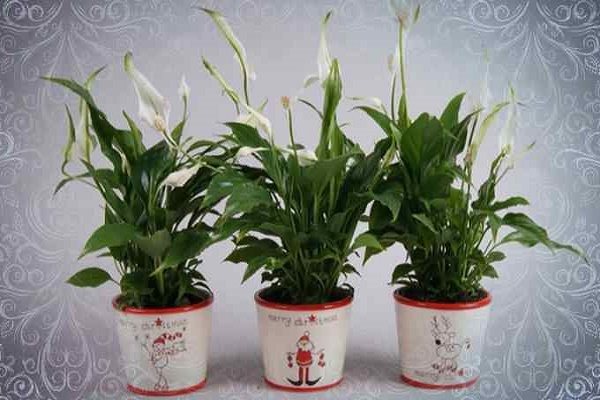

Reproduction methods
Reproduction of spathiphyllum by cuttings
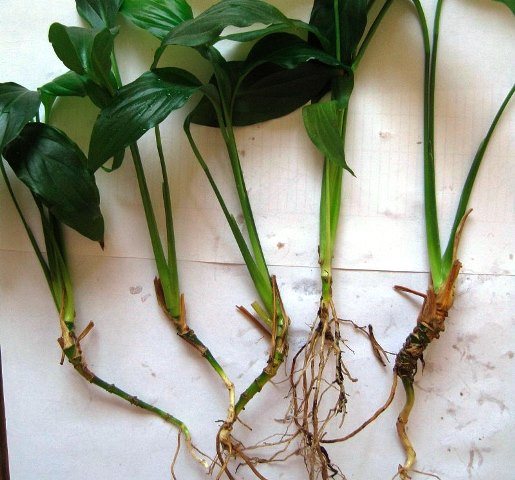

For rooting cuttings of spathiphyllum, it is recommended to use moistened sand. They need warmth (at least 22 degrees). After the cuttings grow roots, they are planted in individual pots filled with a soil mixture consisting of leafy, peat and turf soil, and also sand (2: 2: 1: 1).
Reproduction of spathiphyllum by division
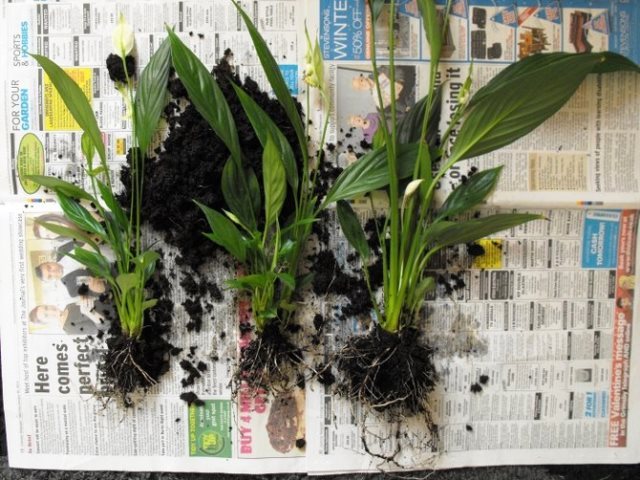

During transplantation in spring, if desired, the flower is propagated by dividing the root. Young points of growth are formed at the shortened stem, and from them new leaf plates appear. If necessary, divide the root into several parts, while each division should have 2 or 3 leaf plates and one growth point. The division is carried out in warmth (approximately 21 degrees). For planting delenok, pots are used, reaching 15 centimeters in diameter, as well as a soil mixture consisting of peat, sand, humus and leafy soil (2: 1: 2: 2), and you also need to add a few pieces of brick, charcoal and bark to it ... You can also use a substrate of coniferous and leafy soil, peat, sand and humus (2: 2: 2: 1: 2). And a soil mixture of leaf, peat, coniferous and humus soil, as well as sand (2: 4: 1: 1: 1) is also suitable. It is recommended to add a small amount of charcoal to it.
Folk omens and superstitions
At all times, they tried to present women and girls with a gift in the form of a spathiphyllum flower. It is believed that the presented flower "Women's happiness" is able to fill the house with harmony and awaken the sleeping feelings of love. This simple houseplant is endowed with magical powers, but, according to legend, it can only make women happy:
- Unmarried girls are given the opportunity to meet their betrothed and get married.
- Married women - to achieve harmony in marital relationships.
- Women without children - to find the joy of motherhood.
It is believed that in the house where the flower blossomed, family life begins to improve, disputes and disagreements, irritations and misunderstandings between family members go away.The soul, as it were, becomes free from the accumulated grievances and disappointments. Firm faith in oneself and in one's own strength is returning. In order for the energy of this flower to be able to perform a miracle, the most important thing is to believe in it. For all of the above, it is necessary to create favorable conditions for the plant for its normal growth and development.
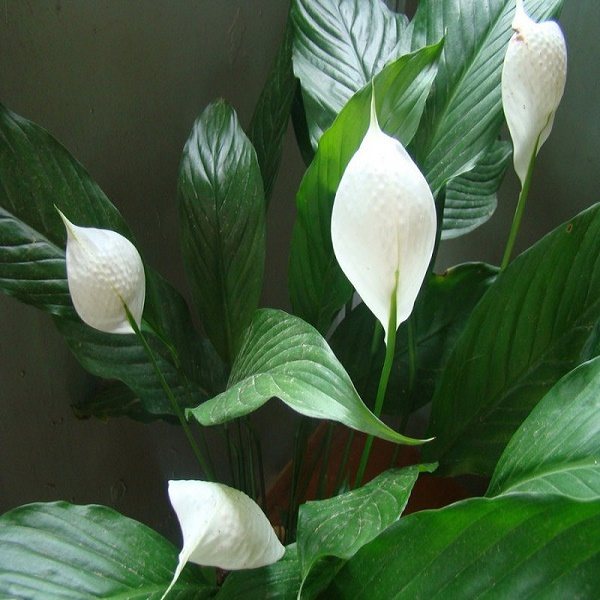

Spathiphyllum chopin home care
Description
Spathiphyllum Chopin is an evergreen ornamental crop characterized by large and dark veined leaves. The plant has no stem. Due to the pressed-in veins, the sheet acquires a folded appearance. Multiple inflorescences look like a white bedspread and a yellowish cob (you can read about other popular varieties of spathiphyllum with white flowers here).
They have an incredible aroma. It is more pronounced in the morning, and subsides in the evening. Flowering begins in spring, but there have been cases when the buds bloom in the fall. In terms of care, the culture is not picky, it tolerates shade well.
If you properly care for the plant and create full-fledged conditions, then flowering will last throughout the year. The first flowers will appear within six months after planting.
History of appearance in Russia
Spathiphyllum - types of flower, description of what they look like
Spathiphyllum belongs to the Araceae family, native to tropical America. Europeans learned about it after the German scientist Gustav Wallis discovered and described the plant. Wallis did not return from the expedition, one of the species of the flower was later named after him - Spathiphyllum wallisii. In the 19th century, they began to cultivate this plant in Europe, at the same time it penetrated into Russia.
New varieties of spathiphyllum began to be developed not so long ago - 50-60 years ago. Spathiphyllum Chopin appeared as a result of the work of breeders.
Growing difficulties
Incorrect lighting, fertilization and watering regimes can cause alarming symptoms and a general weakening of the plant.
Lack of flowering
Sometimes spathiphyllum does not bloom at all or sheds leaves and buds. Possible reasons:
- lack of light;
- too large a pot;
- there is no rest period;
- lack of minerals in the soil.
Leaves turn pale
Leaves lose intense light due to lack of light.
The tips of the leaves dry
If the tips of the leaves turn black and dry in spathiphyllum, then the following care errors are likely:
- lack of fertilizers;
- too abundant and frequent watering;
- lack of moisture.
Important! When the plant withers from lack of moisture, the pot is immersed in a container of water, kept there until the bubbles stop rising, then the water is allowed to drain.
Brown spots on the leaves
This also includes the problem of why the lower leaves fall.
Possible reasons:
- sunburn;
- rotting due to stagnant water in the soil;
- excess fertilizer.
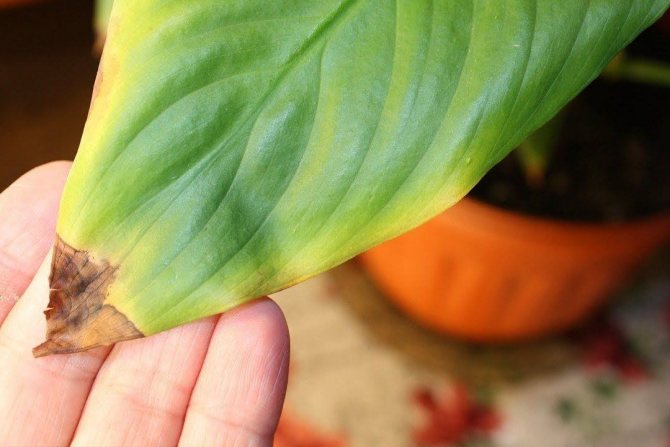

Dried tips of spathiphyllum leaves
When overfeeding the plant, it should be transplanted into fresh substrate immediately.
Pests
Plants weakened by improper care can infect pests: spider mites, aphids. They get rid of them when treated with insecticides (Aktara, Aktellik, etc.).
Why do the leaves of Spathiphyllum turn black and dry?
We recommend reading our other articles
- Chinese silk chicken - characteristics of the breed
- Top dressing tomato seedlings
- Angora rabbit
- Quail brooder
According to the state of spathiphyllum, it is usually easy to understand that something is missing or there are other problems.
- Of the pests, female happiness is most often annoyed by thrips, spider mites, mealybugs. They fight them by spraying with special preparations that can be purchased at any flower shop. For example: "ExtraFlor", "Fitoverm", "Actellik", "Bona Forte", "Iskra Zolotaya", etc.
- If the leaves are drooping, then the plant has little moisture.
- Brown specks on the leaves of female happiness indicate too much nutrients in the earth.In this case, you must either transplant the plant, or stop feeding for 2-3 weeks.
Interesting!
Spathiphyllum is an incredibly useful houseplant. It cleans the air from formaldehyde and trichlorethylene, and also picks up mold spores, reduces humidity in the room.
- Lack of flowering for a long time indicates a lack of nutrients in the earth. A simple top dressing with universal fertilizer for indoor flowers will help to correct the situation.
- Why do the tips of the leaves of Spathiphyllum dry? If there is too much watering or, on the contrary, little, the edges of the leaves begin to turn yellow and dry.
- Why do the leaves of Spathiphyllum turn black? Blackened and dried leaves are a sign of a lack of phosphorus and nitrogen. To solve the problem, you need to purchase a good flower fertilizer (there should be a lot of nitrogen and phosphorus in the composition), and top dressing every 1 week (2-3 times).
- Female happiness can grow in any room, even with minimal lighting, but if you keep it in the shade all the time, the leaves will begin to shrink. So if the new leaves grow small, then you just need to move the plant to a lighter place.
Beneficial features
Besides the magical powers attributed to this flower, Spathiphyllum Picasso has a number of properties that are beneficial to human health:
- like most indoor plants, it saturates the room with ozone;
- is able to trap in the air and neutralize such harmful substances as acetone, formaldehyde, carbon monoxide and other impurities hazardous to health;
- helps to reduce pathogenic microorganisms in the air due to the release of biologically active substances;
- humidifies the air.
What is the difference from other species?
The Chopin variety differs from other varieties of spathiphyllum in that it is not demanding in terms of care. Besides, the plant blooms well even in dim lighting... The flowers give off a delicate and pleasant aroma. And the resistance to common diseases makes Chopin even more in demand among gardeners.
Do you want to know about other popular types and varieties of spathiphyllum? Read articles by our experts with descriptions, photos and recommendations for growing a miniature Strauss, gentle Alana and Sensation, beautiful Domino, amazing Picasso, notorious Wallis spathiphyllum, charming Sweet and lovely Cupido.
How much does an adult plant cost in a store?
The unique appearance of Picasso's spathiphyllum makes it quite popular among flower growers, which also determines its cost. Prices for an adult plant, which is also very difficult to find in stores, are quite high and, depending on age, size, color features the cost can be from 1000 to 5000 rubles or more.
But if there is a great desire to have this rare indoor flower at home, and it is difficult to buy it, you can always try to grow the plant yourself.
Benefits and signs
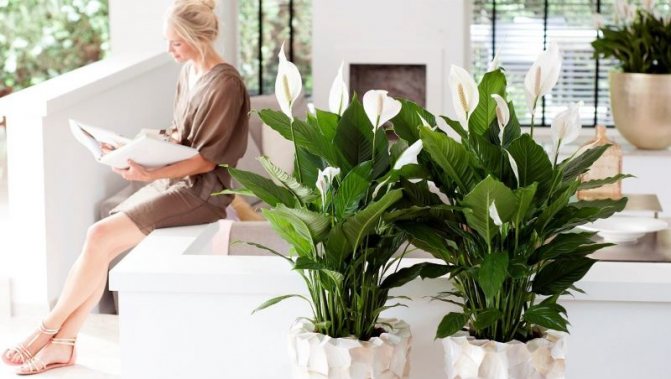

Spathiphyllum is popularly called differently. For its resemblance to a ship's sail, it is called "White Sail" or "Flagleaf". There are other names - "Woman's flower" or "Woman's happiness". According to legend, the goddess of love Astarte breathed into this white flower a particle of happiness that overwhelmed her on her wedding day, and gave it to earthly girls so that he would help them find a happy family. Since then, Spathiphyllum brings happiness to everyone who believes in its power.
Many signs are associated with this plant and they are all positive. It is believed that Spathiphyllum has magical properties during flowering, because at this time miracles happen in the house, for example:
- unmarried girls always meet their betrothed;
- spouses stop quarreling and begin to live in peace and harmony;
- a long-awaited child appears in childless families.
In addition, it has been proven that Spathiphyllum cleans the air of the room from harmful compounds such as formaldehyde, benzene, toluene, carbon monoxide and others.It significantly reduces the number of harmful microorganisms in the air, moisturizes and saturates it with ions and phytoncides that inhibit the growth of molds. Spathiphyllum leaves saturate the air of the apartment with ozone, the increased content of which creates the atmosphere of the mountains. The presence of 4 - 5 bushes of this amazing flower in the house will increase the content of oxygen ions tenfold, which is beneficial for everyone living in the house.
True, at first you will have to take good care of the plant so that it itself is healthy and capable of blooming, in order to work miracles and fulfill your innermost desires.
Photo
Below you can see a photo of the plant.
Portrait by Picasso
The variety is bred from the tropical natural species Wallis spathiphyllum. From the progenitor, the plant took over its unpretentiousness to living conditions. The breeders gave the representative of the home flora an unusual coloring of the leaves with wide white and green strokes. Even the “blanket” has a motley coloring and a shape that resembles a sauce spoon with a pointed end.
Pablo Picasso is the most expensive artist, according to Christie's; according to fans - the best artist of the century; according to law enforcement agencies - the most abducted creator. Spathiphyllum leaves resemble incomprehensible puzzles of Picasso's cubic period paintings. A photo of Picasso's spathiphyllum reflects the richness of the pattern and shades.
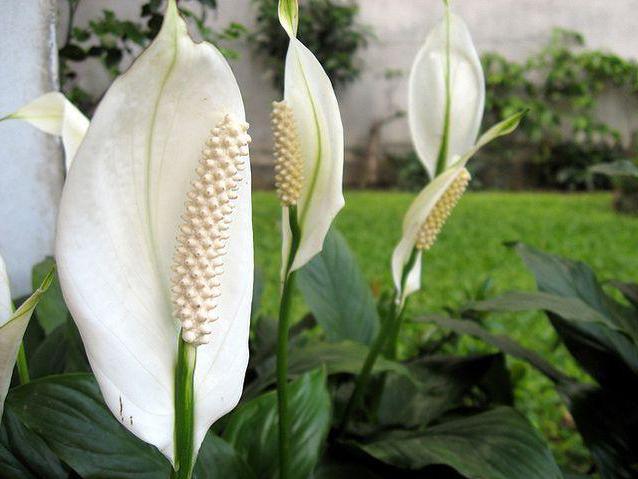

Large varieties of spathiphyllum
Miniature indoor plants are good for city apartments, but large flowers look appropriate in large country houses and offices. In terms of the complexity of growing, they are no different from spathiphyllums of other sizes. Tropical giants love diffused light, periodic feeding, regular moistening of an earthen coma. It is important to find a suitable pot for them. A cramped planter interferes with normal development, and too spacious pots off the beginning of flowering.
Sensation
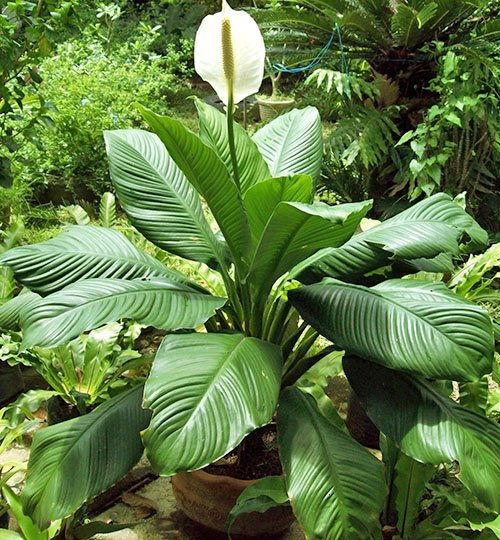

The gigantic size of the leaves immediately attracts attention. With proper care, the bushes reach 1.5 m in height. The main characteristics of the hybrid:
- length of sheet plates up to 80 cm, width 40 cm;
- the color is dark green, glossy;
- inflorescences are large (about 50cm), at first white, then turn green.
One of the varieties that are not afraid of blackout. For better development of the bush, it is desirable to water it with settled soft water.
Heliconiophilous
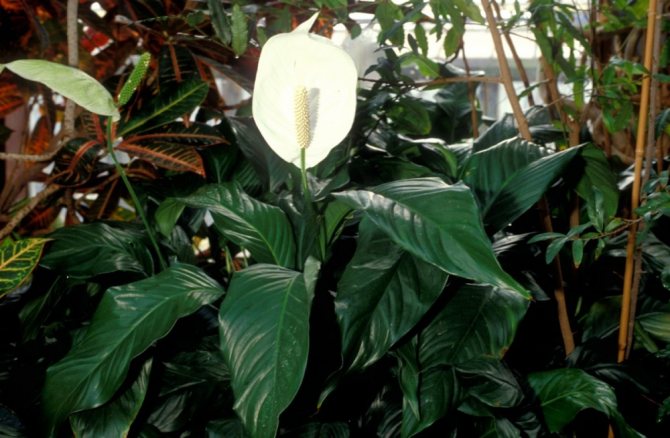

Large variety with rich dark green leaves. The bush reaches 1 m in height. Key Features:
- the sheet plate is oblong, glossy, up to 0.5 m long and about 0.25 m wide;
- cob up to 10 cm long, white, darkens as it ripens;
- the edges of the foliage are slightly wavy.
Spathiphyllum loves diffused light, moderate watering, sprinkling. Can develop in partial shade and shade.
Sell or donate
The green plant decorates the interior and pleases the soul. Force majeure will require you to remove him from the house.
Throwing such beauty into a landfill is a pity. Therefore, try to sell or donate the plant to another owner.
The option of placing an order for "Avito" Spathiphyllum Picasso is available to every computer owner. Submit a photo and description of the flower: variety, age, conditions of transfer to the new owner. A pretty representative of the blooming tropical flora is in demand in urban environments.
The flower feels comfortable at the latitude of Moscow and further south. Suitable conditions have been created by nature for Picasso's spathiphyllum in Almaty. A mild warm climate, in winter the temperature is not lower than minus 5 ° С, in summer it is not higher than plus 24 ° С. Winter lasts 67 days. The driest month is August. You can order a plant without fear to decorate your home or winter garden.
Seven types of tropical guest
1. The leader in popularity Wallis's spathiphyllum was exported to Europe from the selva of Colombia. Breeders use this species as a base for creating new varieties. The oblong, smooth, dark green leaves of Wallis spathiphyllum grow up to 30 cm and are collected in a rosette. Peduncles also stretch up to 30 cm.Flowers reach 10 cm in size. Height - no more than 40 cm, which is suitable for growing in a room. The white ear is wrapped in a narrow “blanket” that changes color from white to light green. The original habitat gave the flower its unpretentiousness to lighting.
2. Wild blooming spathiphyllum exceeds Wallis in size: height - 60 centimeters; oval leaves, velvety above and matte below, 20 centimeters long and 12 centimeters wide. Gives many peduncles from buds located in the axils of the petioles. Only healthy greens are good for budding.
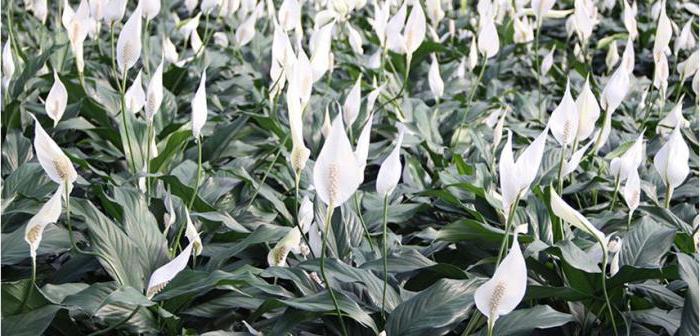

3. Little known in culture, spathiphyllum is adorable even larger than Wallis. Dark green elongated leaves on strong stalks hold a cloud of inflorescences. The "coverlet" of the cob resembles a flag, which makes the look and is original. Compliance with the rules of care will allow the pet to bloom twice a year - in spring and autumn.
4. Common in Venezuela and Thailand, cannoli spathiphyllum with bright green leaves pleases with fragrant flowers on the cob of mixed yellow-green color. It got its name for the resemblance of greenery to a canna. It is almost never found in its pure form in culture. Used for breeding new varieties.
5. The Brazilian spathiphyllum spoon-shaped one meter in height is distinguished by dark green glossy leaves with wavy edges, 20 centimeters wide and 40 centimeters long. The petiole is 70 cm long. The white inflorescence is covered with an oval “veil”.
6. Another Brazilian handsome Spathiphyllum Heliconium is appreciated by flower growers for the beauty of greenery and cob. Options: dark green glossy leaves with a sharp tip and wavy edges, 25 centimeters wide and 50 centimeters long with a 70 cm petiole. A flower with an ear of 10 cm and a color palette from white to black. A snow-white "blanket" in half a notebook page - 10 cm wide, 15 cm long.
7. Dutch breeders domesticate wild plant species and breed hybrids. Spathiphyllum Picasso is one of the creations of pot flower growers.
Detailed description
Picasso variety - a hybrid from the Netherlands, derived from the Wallis spathiphyllum variety... Its height reaches 40-50 cm. In Picasso's spathiphyllum, stems are absent, basal leaves form a basal rosette at the base.
Leaves are wide, long, up to 18 - 23 cm, shiny, medium in density at the ends, pointed. Coloring - bright green leaf sectors are mixed with white areas. Petioles are long, flexible.
The very fabric of the flower is in the shape of a sail, pale white with a green scattering of spots, the ear is light yellow. The root is short.
How is it different from other varieties?
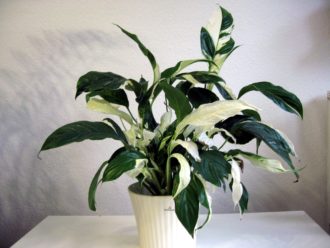

The main thing that distinguishes Picasso's spathiphyllum from most of its counterparts is the original color of the leaves, which is inherent only in this hybrid. In addition to the green segments, the leaves have white areas, which sometimes occupy more than half of the entire surface. Due to this, the plant looks very impressive and at the same time gentle.
Not only leaves, but also flowers can boast of a variegated color.: The cover around the ear is white at first, but gradually light green fragments appear on it.
Variegation is a rare property for spathiphyllums, which makes the Picasso hybrid especially valuable.
In addition, this variety is distinguished by its relatively small size in comparison with other varieties, the spreading of the bush and - which is no less valuable - its particular unpretentiousness.
Signs of the disease
Caring for Picasso's spathiphyllum gives the owner joy. But when the microclimate is disturbed from an excess of fertilizers and from a spider mite, the flower gets sick.
If leaves:
- They brighten, then there is extra light in the room. Cover the glass with a white cloth to protect it from direct natural light. Dim or turn off artificial lights.
- It gets dark, then there is a lack of light in the room.
- Turn yellow, then check the humidity in the room. The second reason for yellowness is aphids. Get a magnifying glass and check the inside of the leaf and the entire outlet near the rhizome.Find aphids - take action.
The spider mite sucks out all the juices from the plant. Isolate the flower from other greenery immediately and try to get rid of the mite.
The leaves of the plant curl when the temperature drops to 15 degrees.
Spathiphyllum ceases to bloom with an excess of fertilizer and when the roots occupy the entire space of the pot.
The inflorescence turns green in a dark and cold room. If a change in the color of the cob and "coverlet" has occurred, then remove all peduncles, leave only one copy.
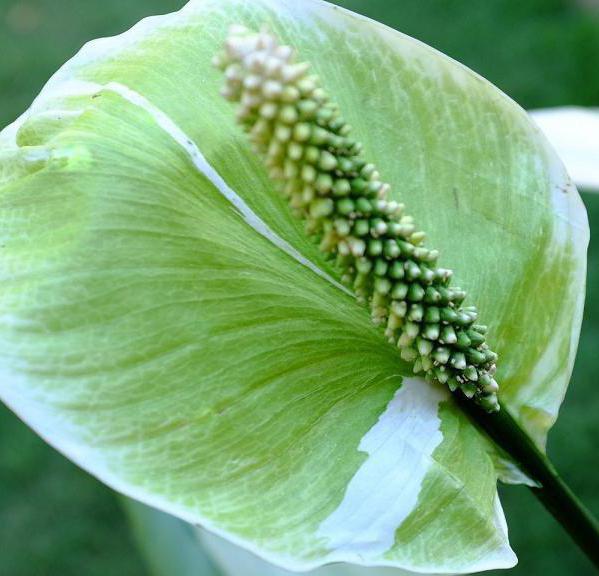

Soil composition
For growing Spathiphyllum, Picasso is not suitable for universal soil. It is necessary to use a special composition, which is easiest to purchase ready-made. It should include high-moor peat, river sand, crushed bark.
In specialized garden stores, ready-made soil is sold, designed specifically for spathiphyllum, which is better to give preference to. A universal substrate for the Aroid family is also suitable.
How to propagate a flower
If you want to get new young plants, then spathiphyllum can be propagated in three ways:
- By dividing the bush... This is the easiest and least time consuming method. When transplanting in early spring, the spathiphyllum bush must be carefully divided into separate shoots, which are then planted as adult plants.
- By cuttings... Cut cuttings with two eyes should be placed in moist soil, covered with foil and placed in a dark, warm place. After the roots appear, transplant in the usual way into the desired container.
- Seeds... Due to the complexity and duration, this method is used less often. After the ripening of the peduncle, it is necessary to collect the seeds, sow them in a mixture of peat and sand, cover with a film and put in a darkened warm place, periodically ventilating and moistening the soil. After a month, the seeds germinate and the sprouts can be planted.
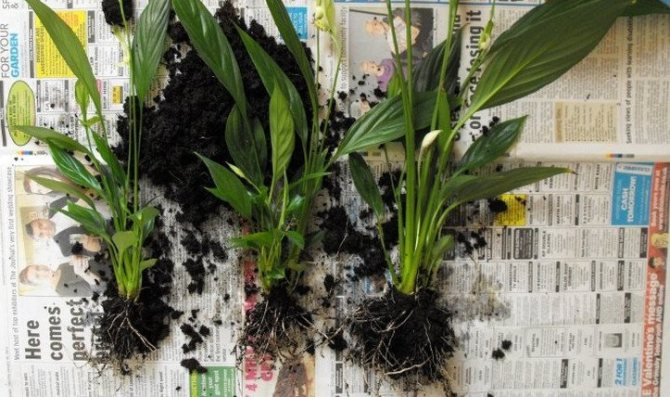

How to propagate Spathiphyllum?
Spathiphyllum is propagated by dividing the bush, cuttings or seeds.
- For reproduction by dividing the bush, you need to free the female happiness from the pot, then clean the roots from clods of earth so that the roots are clearly visible. Then the roots are divided with a knife or scissors. Each small bush should have a growth point and 3-4 leaves. The finished bushes are planted in moist soil (a small pot is taken). In the first few days, they take root, so watering is not needed, but regular spraying is observed to maintain the correct humidity. The first flowering of the transplanted flower can be observed after 8 months.
Important!
The reproduction procedure by dividing the bush is carried out in the spring, during transplantation, so as not to disturb the flower once again. After all, any such machinations are very stressful for him.
- Propagation by cuttings gives good results. Cuttings in this case are leaf sockets, which often have small roots. If there are already roots, you can immediately plant the cutting in the ground, if not, you need to place the outlet in water with activated charcoal so that the roots form and only then plant in a pot.
- Seed propagation is the most laborious process and does not always give results. The fact is that the seeds of this plant lose their germination very quickly - they cannot be stored. Even seeds from specialty stores do not germinate well. They must be sown immediately after harvesting, otherwise, with each day of storage, the chance of getting sprouts will decrease.
After collecting good seeds, you need to sow them in a shallow container (like a plate). The land is made from equal parts of sand and peat. The temperature for germination is + 24 ... + 25 degrees, watering by spraying, and airing is carried out regularly. When strong sprouts with small leaves appear, they can be dived into separate cups.
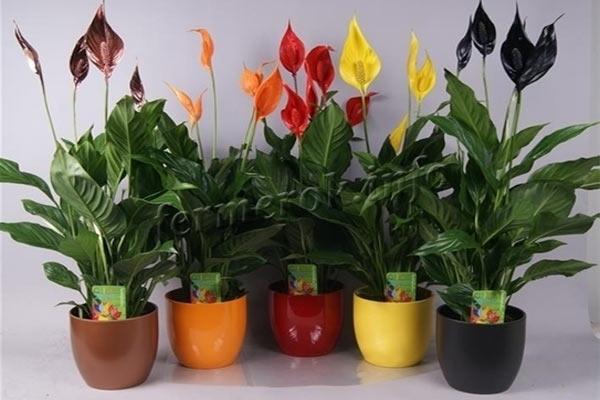

Photo of flowers Spathiphyllum
Bloom
During flowering spathiphyllum chopin opens its "snow-white sails". The inflorescence appears on a long stalk, and around it is covered with a white blanket (you can learn about the cultivation features and varieties of white spathiphyllum here). The buds reach a size of 5-7 centimeters.
When and how?
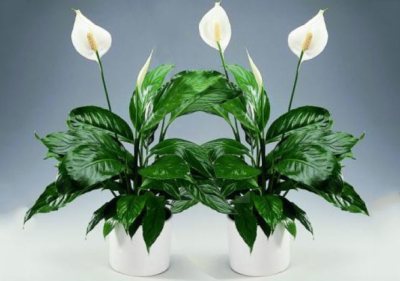

Spathiphyllum chopin is a perennial, therefore it will begin to bloom only when it reaches full development. At first, the plant is actively gaining growth, acquiring new shoots. After he gets strong enough and gains strength, he begins to release a peduncle.
A young flower after a year of life can bloom. Then the buds appear annually. Chopin usually blooms in early spring and pleases the eye until the end of September.
Care before and after
After the flowering period, the spathiphyllum must be prepared for winter rest:
- Faded buds are removed, leaving only 3 centimeters from the rhizome.
- The pot with the plant is placed in a cooler place; now it needs to be watered and sprayed much less often.
- Top dressing will now be required only in the spring, at the beginning of active growth.
What if it doesn't bloom?
Spathiphyllum chopin blooms once a year, but it happens that flowering does not come. This is due to various factors. To speed up the flowering process - create stress for the plant, change the conditions of existence. A positive result is a decrease in temperature to +16 ° C and a decrease in the amount and frequency of watering. Lighting should not be reduced. The soil in the pot is regularly dried.
To stimulate flowering, you can try the use of drugs intended for this. And, caring for the flower correctly and with love, it will begin to delight with a beautiful elegant flowering.

